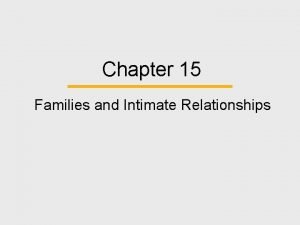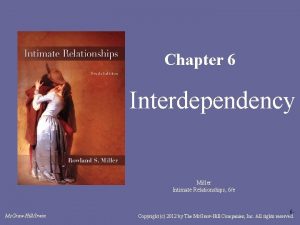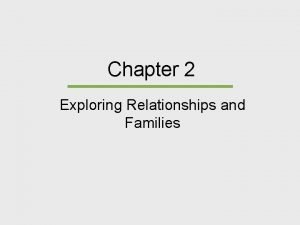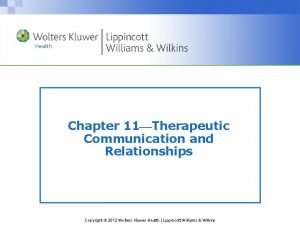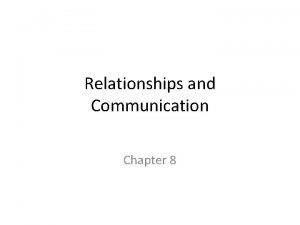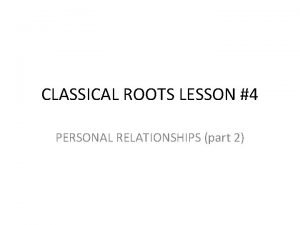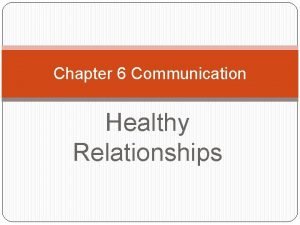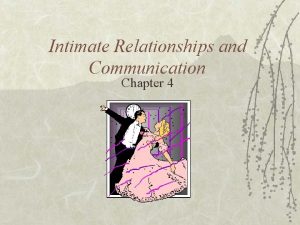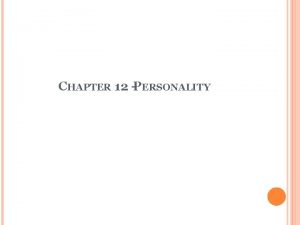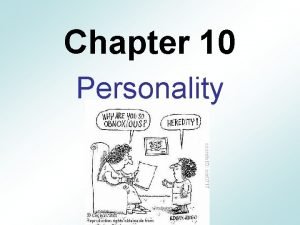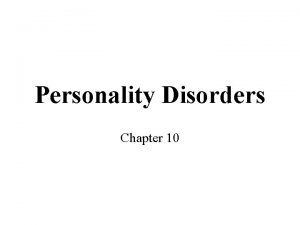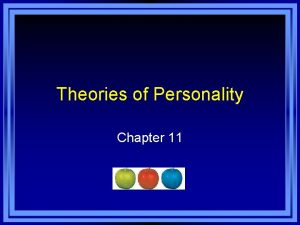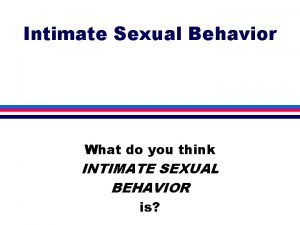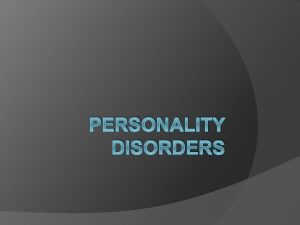CHAPTER 6 Personality and Personal History Intimate Relationships



























- Slides: 27

CHAPTER 6 Personality and Personal History Intimate Relationships, 3 rd edition © 2019 by W. W. Norton & Company

Clive Wearing’s Moments of Truth 2

Personality Traits and Emotional Tendencies • Personality: o Traits that are stable over time o Traits that go together to form a coherent picture of someone • Trait approach: o How relationship scientists study personality 3

How Do Individual Differences Matter in Relationships? • In general, they make a difference in people’s • Relationship expectations • Perceptions of their partner • Relationship behaviors 4

How Personality Traits Affect Our Intimate Relationships In order to study personality, it needs to be operationalized. • Big Five: 5

Negative Affectivity Aspects of negative affectivity include • Low self-esteem • Anxiety • Hostility • Self-consciousness • Pessimism 6

Effects of Negative Affectivity on Intimate Relationships • Negative Affectivity: • Related to relationship dissatisfaction • If person is also impulsive, also related to divorce • Related to jealousy and dependency 7

Effects of Agreeableness on Intimate Relationships Agreeableness: • Related to relationship satisfaction • Partners of people low in agreeableness feel the partner disparages them. 8

Effects of Personality Traits on Intimate Relationships 9

Consequences of Negative Affectivity and Low Self-Esteem 1. Low self-esteem • Like other aspects of personality, low self-esteem tends to be relatively stable over time. • Self-esteem contributes to relationship functioning, both through behavior and through perceptions of the partner’s behavior. 2. Underestimating the partner’s regard for self 3. Perceiving the partner in an unfavorable light 4. Perceiving the relationship in an unfavorable light 10

The Dependence Regulation Model 11

Measures of Personality in Childhood Personality traits exhibited in childhood can predict relationship satisfaction later in life. • Aggression in children under 10 is linked to higher rates of divorce. • Anxious children tend to have lower relationship satisfaction. • Children with poor impulse control have higher rates of conflict. 12

Measures of Personality in Adulthood Personality traits in adults are linked to relationship outcomes. • Those with high levels of negative affectivity have poor relationship outcomes in general. • Personality traits can predict which couples will divorce and which will not. • Agreeableness and conscientiousness are linked to positive relationship outcomes. 13

Childhood Experiences in Families (1) • Early experience in our family of origin makes a difference in our relationship expectations and experiences. • Some aspects of this early experience are o Parents’ relationship with each other o Our relationship with our parents 14

Childhood Experiences in Families (2) Intergenerational transmission effects: The relationships of people’s parents are related to their own relationships. • Parental conflict is related to children’s subsequent divorce likelihood. • Parental marital satisfaction is related to children’s subsequent marital satisfaction. • Parents’ relationship behavior is related to children’s subsequent relationship behavior. 15

Family Transitions and the Well-Being of Children • Despite such intergenerational transmission effects, parental divorce is not always negative. • If the parental relationship was filled with conflict, divorce is related to better outcomes for children. 16

Divorce and the Psychological Well-Being of Children 17

How Childhood Experiences Influence Later Relationships 1. Children with turbulent family backgrounds are more cautious toward relationships, and more accepting of divorce. 2. Children from unstable families have less money and smaller social networks in adulthood. 3. Children from unstable families experience more relationship distress. 18

The Social Learning Theory View • The social learning theory view on intergenerational transmission of relationship behaviors • Children learn emotional and behavioral models by observing and interacting with their families of origin. o Nurturing relationships with parents lead people to feel more connected to a partner. o Abuse and neglect predict less fulfilling adult intimate relationships. o High-conflict families predict the use of less positive communications behaviors. 19

Parental Divorce and Relationship Communication 20

Early Relationships with Caregivers The relationships that parents have with their children are also related to children’s relationship outcomes. 21

The Attachment Theory View Attachment style: stems from children’s relationship with their parents • Based on people’s views of themselves and their views of others • Involves two dimensions: o Anxious o Avoidance 22

Attachment Style and Relationships • Attachment style colors how people • Perceive their partner’s behavior • Behave with their partner 23

Working Models of Attachment Theory Self-relevant aspect of anxiety: When caregivers are inconsistent and unavailable, we feel anxious, insecure, inadequate, and unworthy of care and attention. Other-relevant aspect of avoidance: When we conclude that others are unreliable and are best avoided. • People who are low in anxiety and avoidance are considered to be securely attached • People who perceive themselves to be low in self-worth and others to be unapproachable are considered to be insecurely attached. 24

Attachment Style and Seeking Comfort • Behavioral differences in people with different attachment styles can be clearly seen when they are experiencing stress: • People with secure attachment styles turn to their partner for comfort. • People with avoidant attachment styles avoid their partner as they experience higher levels of stress. 25

Individual Differences in Relationships • People begin relationships with different experiences and personalities. • These experiences and personalities color—but do not dictate —how they perceive their partner and how they behave in the relationship. 26

Overcoming Insecurity Research demonstrates solutions to decrease insecurity in relationships: • Deepening self-affirmation • Adopting your partner’s perspective • Elaborating on a compliment • Increasing your psychological and physical closeness 27
 Family life today
Family life today Intimate family chapter 7
Intimate family chapter 7 Intimate family chapter 7
Intimate family chapter 7 The impact of incarceration on intimate relationships
The impact of incarceration on intimate relationships Intimate family chapter 6
Intimate family chapter 6 Intimate family chapter 6
Intimate family chapter 6 Meaning of initmacy
Meaning of initmacy Intimate family chapter 2
Intimate family chapter 2 What is intimate distance
What is intimate distance Casual register example
Casual register example Dewgarden foaming intimate wash benefits
Dewgarden foaming intimate wash benefits Intimate zone in communication
Intimate zone in communication Intimate zone in communication
Intimate zone in communication Relaxed antonym
Relaxed antonym 01 me line intimate
01 me line intimate Relationship guidelines chapter 8
Relationship guidelines chapter 8 Periwinkle doerfler
Periwinkle doerfler Cause of death
Cause of death Principles of ecology section 2 flow of energy
Principles of ecology section 2 flow of energy Chapter 2 section 1 organisms and their relationships
Chapter 2 section 1 organisms and their relationships Section 1 organisms and their relationships
Section 1 organisms and their relationships Principles of ecology chapter 2
Principles of ecology chapter 2 Jokes about communication
Jokes about communication Priorities in a healthy relationship
Priorities in a healthy relationship Chapter 2 section 1 organisms and their relationships
Chapter 2 section 1 organisms and their relationships Formas no personales del verbo en infinitivo
Formas no personales del verbo en infinitivo Adivinanzas de higiene
Adivinanzas de higiene Pansariling pagtataya
Pansariling pagtataya
